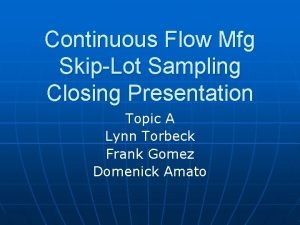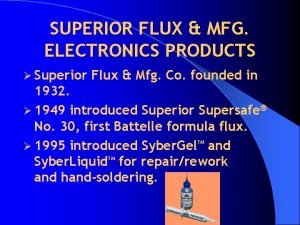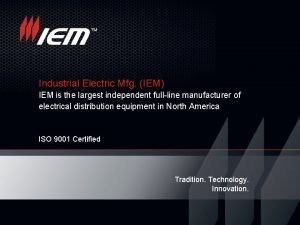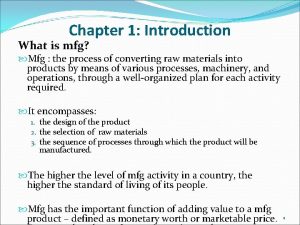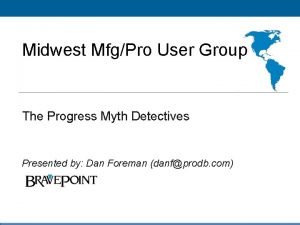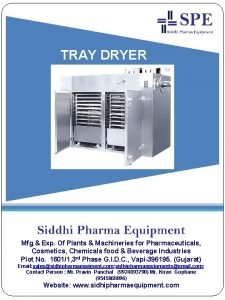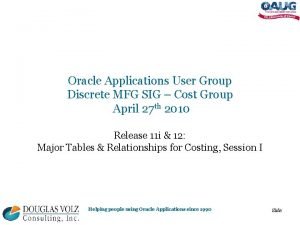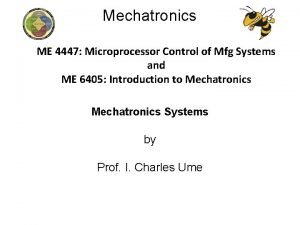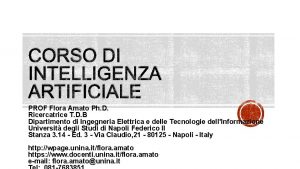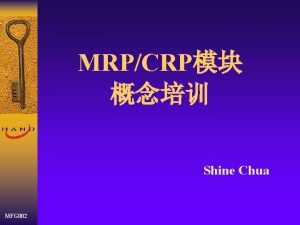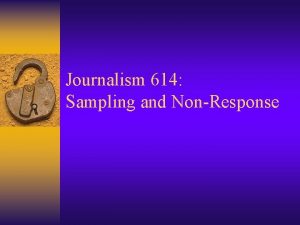Continuous Flow Mfg SkipLot Sampling Domenick Amato Frank














- Slides: 14

Continuous Flow Mfg Skip-Lot Sampling Domenick Amato Frank Gomez Lynn Torbeck

21 CFR 210. 3 n n 210. 3(20) “Acceptance Criteria means the product specifications and acceptance/rejection criteria, such as acceptable quality level and unacceptable quality level with an associated sampling plan …” 210. 3(21) Representative samples

21 CFR 211. 84 n Requirements: 1. 2. 3. 4. 5. 6. Representative samples Number of containers to sample Amount of material to be taken Variability – Process average Confidence levels Past quality history

Continuous Flow Mfg n n How to define a continuous process? Types of processes? How to define a “lot” or “batch” in a continuous flow process? Assumption of homogeneity of product? Assumptions about defects?

Types of Sampling Plans n Variables Plans: • ANSI/ASQ Z 1. 9 n Attribute Plans • ANSI/ASQ Z 1. 4 • ISO 2859

Sampling Plans Defined n n n Population of units, lots or batches AQL: Acceptable Quality Limit LQ: Unacceptable Quality Limit Sample size Accept number Reject number

Risk Management n n n “Producer’s Risk” The probability that a good lot is rejected by the customer. (Type I error or alpha) “Consumer’s Risk” The probability that a bad lot is accepted by the customer. (Type II error or beta) Levels not fixed but common values are 5% and 10%.

Assumptions for Sampling n Representative samples • Beginning, middle and end • Top, middle and bottom • Every 30 minutes or 100 units • Random Sampling – (difficult) n n Defects must be randomly distributed ! Sample inspection is 100%

Reduced Testing 1. 2. 3. 4. Smaller sample size. Using General Inspection Level I in place of Level II or III in Z 1. 4. Not inspecting all characteristics on the Co. A or listed in the USP. Can use reduced testing in Z 1. 4. Use the switching rules in Z 1. 4.

Skip-Lot Sampling n n n Not all lots are tested. Only a fraction of lots are inspected. Goal is to save money or time and still achieve quality products.

Types of Skip-Lot Sampling 1. 2. 3. Test every “nth” lot, not random. Test “i” lots, if all pass go to a fraction, “f”, of future lots. Select i and f in advance. Lots selected at random. ASQ S 1, i and f are determined from the data collected. Lots are selected at random using dice.

Assumptions for Skip-Lot n n Supplier and customer agree on a plan. Good communications. Faith and trust in an honest supplier. Good relations. Proven history of quality with a stable and continuous process. Clear criteria for action plan.

Discussion Topics n n n n Compendial requirements Regulatory expectations Current state, pro/concerns Desired state for excipients Fraud, counterfeiting, adulteration Processes “Out of control. ” Changes without notification

References n n n NIST http: //www. itl. nist. gov/div 898/handbook/pmc/section 2/pmc 22. htm http: //www. itl. nist. gov/div 898/handbook/pmc/section 2/pmc 27. htm http: //www. itl. nist. gov/div 898/handbook/pmc/section 2/pmc 23. htm ASQ (1996). ANSI/ASQ S 1, “Attribute Skip-Lot Sampling Program. ” Schilling, E. (1982). Acceptance Sampling in Quality Control, New York, NY: Marcel Dekker, pp 443 -451 Juran, J. and Godfrey, A. (1999). Juran’s Quality Handbook, Fifth Edition, pp 4631, 46 -32, New York: Mc. Graw Hill.
